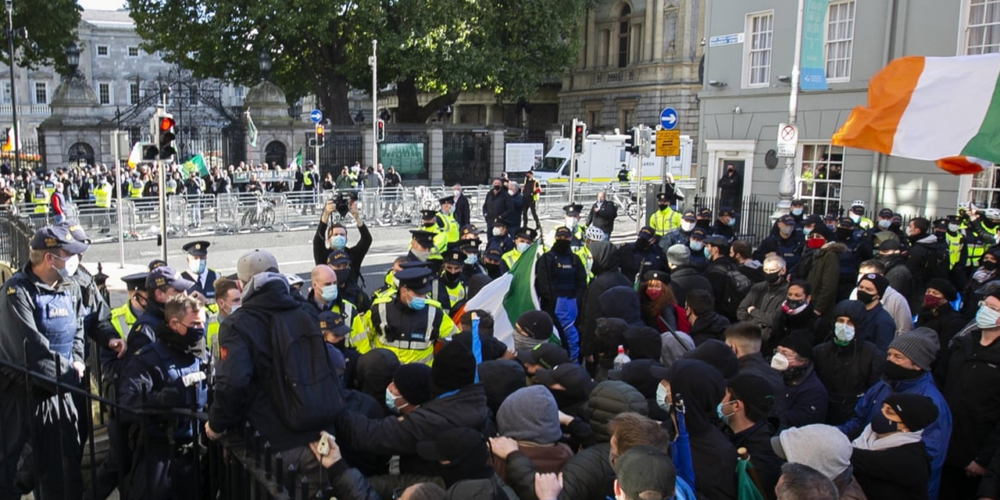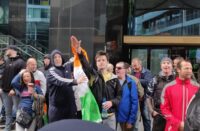(Pádraig Mac Oscair is an author and activist based in Ireland. His writing can also be read in Mionlach, Rupture and Socialist Voice. He can be found on Twitter at @PMacOscair)
In recent months, the inner-city Dublin community of East Wall has seen a persistent series of protests against the potential housing of refugees in a disused office building in the area. The initial protestors claimed to have been objecting to the fact that the community were not consulted over the proposal, and to be acting from a place of concern for the safety of local residents. Additionally, a number of those protesting were angry at the prospect of refugees being housed ahead of those in emergency or homeless accommodation in the midst of the worst housing crisis in the state’s history.Similar protests against housing refugees in hotels and other vacant buildings erupted in other parts of Dublin and in some rural areas in the following weeks. The protestors claimed to have similar complaints to those in East Wall, over not having been consulted and concern at the disruption that moving refugees into the area en masse would create. A combination of long housing waiting lists alongside soaring private sector rents, a dysfunctional refugee accommodation system and a repeated failure to consult or include locals when housing the influx of refugees created by the Russian assault on Ukraine hadn’t helped, and had been breeding resentment towards these policies for some time.However, it didn’t take long for it to become clear that there were darker forces aligned with this particular wave of protests. A protest broke out in the Dublin suburb of Drimnagh over the unsubstantiated rumour that a local primary school was to be used to house refugees, and a building in Dublin’s Sherrard Street was set ablaze following speculation it was to be used to house refugees. As individuals known to be members of far-right groups such as the Irish Freedom Party and the National Party became increasingly visible, it soon became clear that these protests fit within a long-term tendency in recent years for far-right activists to organise around sites proposed for direct accommodation centres, aping their British counterparts strategy of exploiting public concerns about asylum seekers being moved into an area. This was confirmed as prominent far-right activists such as Hermann Kelly of the Irish Freedom Party used the East Wall protests as occasion to talk about tampons in the mens toilets at the Dáil and another organiser, claiming to be a supporter of the National Party, threatened to burn down a hotel in Kildare housing asylum seekers. The arrival of veteran British racist organiser Stephen Yaxley-Lennon, cosplaying as “Tommy Robinson”, provided further evidence that these protests were at least partially the result of British agitators exporting their tactics of scaremongering and disinformation into Ireland. Despite this, sections of the Irish media have been slow to acknowledge that these protests are evidence Ireland has a far-right problem. Mick Clifford, in an article published in The Irish Examiner on 25 August 2022 following the Global Project Against Hate and Extremism (GPAHE)’s report on Ireland, went so far as to dismiss the idea that Ireland had a far-right problem as alarmism. Clifford stated that “Irish society is not immune to racism or bigotry, but compassion remains a bedrock value”, as if Irish people have an innate decency rendering them immune to far-right organising despite the same material factors in housing, unemployment and the generational breakdown of mass party membership that led to the emergence of mass racist parties in France or Britain in recent decades. This has been demonstrably untrue for several years following the emergence of the likes of the National Party and a wave of far-right anti-lockdown organising in 2020. Clifford evidently learned nothing from the involvement of far-right activists in the East Wall protests, and went so far as to describe the far-right’s efforts to organise around refugee centres as a “damp squib”, owing to low turnout, in an article published on 13 January 2023 . Such an attitude is wishful thinking at best and disingenuous at worst given the far-right remains far more visible in Ireland than at any point in several decades. It’s also actively dangerous given the importance of the media in legitimising the far-right. The importance of the media to the normalisation and growth of the far-right in the United Kingdom and France was identified and scrutinised by Aurelien Mondon and Aaron Winter in their book Reactionary Democracy. The media in these countries, whilst also contributing to the visibility of the far-right by giving airtime to figures such as Jean-Marie Le Pen or Nick Griffin, also legitimised far-right ideas within mainstream conservatism by misrepresenting what the far-right actually were and creating distorted narratives which, owing to the media’s capacity as opinion-formers, helped shape public opinion onto more favourable terrain for racist organisers. Of course, no two countries can have the exact same political context or trajectory. Ireland may not have had an Enoch Powell moment in which an established politician decides to pursue a second career as an anti-immigration activist, emboldening the fascists to come out of hiding in the process and mainstream politicians to talk about their constituents feeling “swamped” by migrants in a moral panic that’s gone on for over 50 years.
Ireland’s state broadcaster RTÉ has refrained from inviting representatives from the National Party to speak on national television, yet there are still a number of figures in the Irish legacy media who’re already repeating many of the errors which saw the FN in France and UKIP in Britain being normalised. This is due to failing to take the far-right seriously due to being more interested in using them to make broader political points against long-standing enemies on the left. The far-right and the left are presented as two sides of the same coin, as seen when a racist effort to intimidate people in their homes and an antiracist demonstration were presented as “rival protests”. Two particularly egregious examples of this tendency are the work of Eoin O’Malley, a lecturer in Politics at Dublin City University and Éilis O’Hanlon, a journalist who’s enthusiastically taken to importing many of the United Kingdom’s most noxious talking points about the transgender community into a country whose 2015 Gender Recognition Act is widely regarded as one of the most progressive and inclusive of its kind in the world. Both of them write for the Irish Independent, Ireland’s most widely-read broadsheet. In both cases (and the aforementioned Mick Clifford article), the authors are more interested in demonising movements on the political left than offering any serious analysis of the East Wall protests. Eoin O’Malley, in an article published on 12/02/2023, goes so far as to blame the water charges protests which gripped Ireland from 2014 to 2017 for the East Wall protests, on the grounds that the water charges protests “radicalised” many people in working-class communities, infecting them with what he perceives as a conspiratorial worldview amongst sections of the Irish left: “Anti-globalism and anti-EU sentiment has been a part of the far left movement in Ireland. But if you ask your followers to believe that there is a global economic elite with Nato as its army and the EU as its lapdog, it’s not long before some of them wander off the range and see other conspiracy theories everywhere.”
For O’Malley, acknowledging the existence of the colonial process that sees sweatshop labour in China being used to give people in Europe cheap shoes means going down a conspiracist rabbit hole leading inevitably to acceptance of Great Replacement Theory. He proceeds to claim that the two protest movements, 8 years apart from one another, are ultimately much the same thing. “It is a good example of ‘horseshoe theory’ in action, where like a horseshoe as people travel along to the edges of the political spectrum, the far left and the far right become almost indistinguishable.”Setting aside the absurdity of this claim for now, what’s far more worrying is how glibly O’Malley treats the far-right in 2023 in his zeal to demonise a movement that petered out several years ago. The far-right element of the protest movement have launched arson attacks on refugee accommodation and linked in with known extremists from other countries, but O’Malley has far more enthusiasm for using his podium to blame “the left” than in conducting any analysis of the background or positions of the movement.This disingenuousness is even more pronounced in Éilis O’Hanlon’s article “If the left can’t represent people with gripes against the State, someone else will” of 19/02/2023, which claims that the emergence of the far-right is due to the overwhelming dominance of the left in Irish society and their exclusion of “the people”, on the grounds that the left have fallen out of touch with the real priorities of the working-class. For O’Hanlon, it doesn’t matter that there are major issues in Irish society creating favourable conditions for the far-right or an observed upsurge in racist organising regardless of what the left do: “The left always lose the plot when presented with such democratic evidence that they do not share the values and concerns of genuine working-class communities like East Wall. Their last remaining play is invariably the same — to suggest that those who disagree with them are misled by lies and fake news.”This claim echoes many of the tropes identified by Mondon and Winter in their analysis of the mainstreaming of the far right in France and Britain, particularly the representation of the far right as a radical alternative to a dominant “woke” or “liberal” political and media class and the demonisation of the working-class as some sort of undifferentiated mass without agency just waiting to be stirred in a given direction by far-right agitators due to the actions of “out-of-touch” elites. Accordingly, the working-class can be blamed for phenomena like the election of Donald Trump or Brexit regardless of evidence showing these were predominantly middle-class movements (Trump polled lower amongst working-class whites in 2016 than Bush had in 2004). This false narrative of “the people” has two major consequences. Firstly, it legitimises and disseminates the far right’s own claims to be speaking for the “left-behind” in society when they present immigration as something “done unto” white people. Secondly, the media inadvertently promotes the idea of the far right as an anti-establishment force regardless of their actual policies. Taken in combination, these create a false dichotomy wherein the rational, enlightened media and political class are on one side and “the people” on the other, exposing the public to a media-created narrative wherein the far right can claim authenticity and thus generate support. The work of Clifford, O’Malley and Hanlon, all published in major national newspapers, represent the early stages of this process in an Irish context. All three treat the far right as either an irrelevance or an expression of “authentic” public anger in their haste to demonise their existing enemies on the left. In doing so, they repeat the errors made in Britain, the US and France which have helped the far right move from an irrelevance to centre stage within a generation.What then, does this teach anti-racist activism in Ireland? Whilst there are several excellent anti-racist journalists (Shamim Malekmian and The Beacon, for example), the legacy media still has much wider reach and influence. To this end, anti-racist activity in Ireland has to include calling out distorted coverage and the spread of misinformation about the far right if their rise is to be held back at this early and critical stage, and the media held accountable for their role in potentially legitimising them by failing to provide accurate and critical coverage. Without this, the Irish media could well repeat the same abrogation of responsibility that has wreaked havoc across British and French society.






